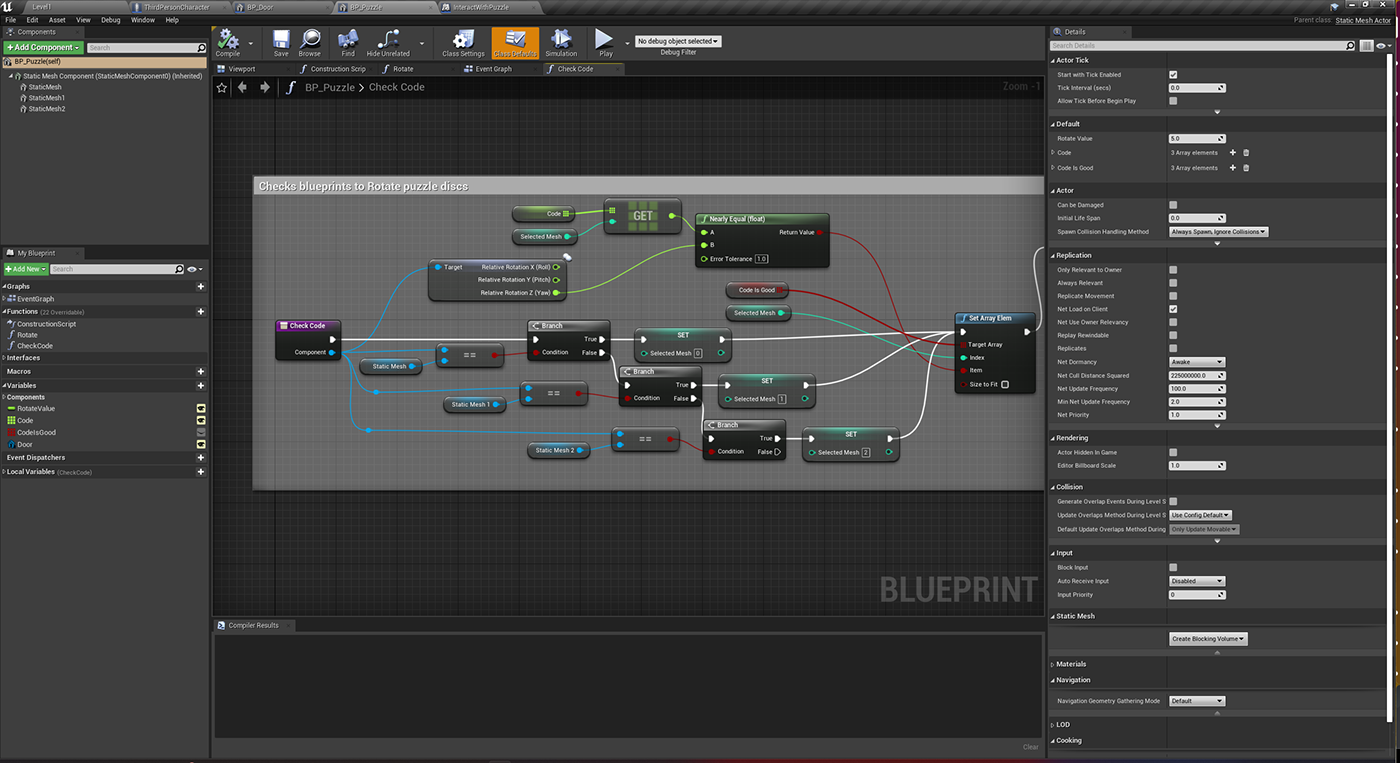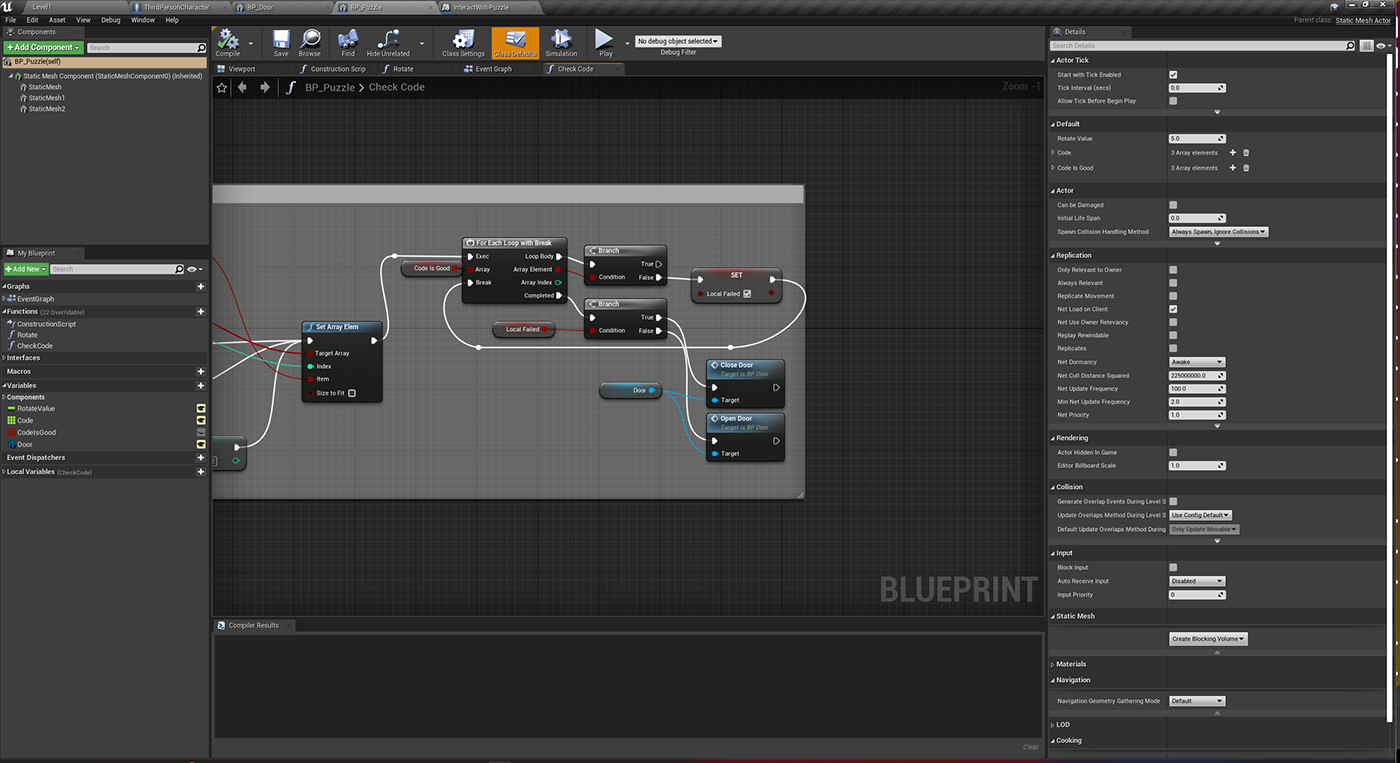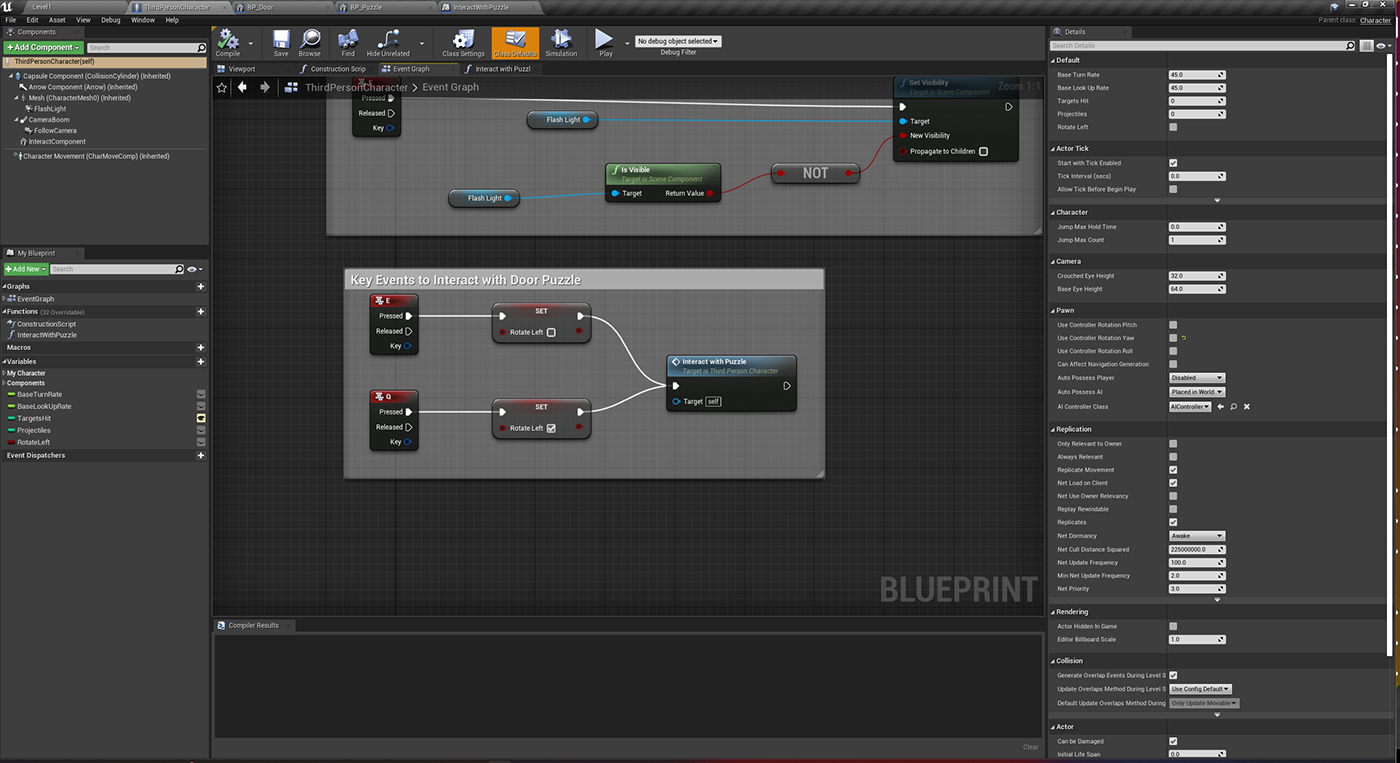



Artifact 1
Ghost Hunter Training
Artifact 1 is a Ghost Hunter's Training game where your character is going through a test to become the next Ghost Hunter in the Corp. The first level takes place outside in a wooded area. They must traverse the terrain to shoot a number of ghost targets before they can enter a haunted house on the other side of the map. They come equipped with a flashlight and their standard issue firearm. Level 2 takes place after they complete level 1 and shoot all of the ghost targets. Here, they must solve a puzzle to gain access to an upper room where a chest holds their certificate of completion and admittance to the Ghost Hunter's Corp.
Here shows the level concept of an outdoor environment set during the late evening. This will exhibit the base gameplay of hunting ghosts by shooting targets. It will also showcase functionality of a togglable flashlight.
The 2 images below show blueprints that check the code of the puzzle functionality to ensure it works properly.


Blueprint to open the door when the player completes the puzzle.

Blueprint of a linetrace to interact with the puzzle discs.

Key bindings to rotate the discs in 2 directions.

Function to rotate the puzzle discs.

This video shows a more detailed view of the flashlight function.
Keybind to toggle the flashlight

First showcase of the game recorded during original class. This is before the flashlight and puzzle game are included. Trees and sky are also different.
Creating this project in GAM 207 was the introduction to Unreal Engine, Blueprints, and game production in general. I really had no experience before this class and had a lot to learn about what I was using to work on the project. I knew basic coding concepts from previous classes that helped me figure some aspects out, but overall, I was somewhat lost and confused about how the blueprints work and how they interact with each other. Fast forward to the present, I have now dusted off the cobwebs on this project after a couple years and after learning more concepts in coding, I was able to add more to the project to refine and polish the gameplay and overall aesthetic of the game. I didn't know it at the time, but I really started becoming interested in gameplay design and programming while in the class and how it ties into the overall enjoyment of the game. With using the flashlight to solving the puzzle, there is a cohesiveness to how the game plays when everything is put together. These elements coming together wasn't without its challenges. For example, the ghost targets didn't seem to work like I wanted them to. It took a lot of tweaking and trying different things to get them to disappear when they are struck by the projectiles. In the end, I managed to get a desired effect and it works for what I want.
Artifact 2
Treasure Hunter
Artifact 2 is a Treasure Hunting game which sets players on an uncharted island to dig for buried treasure. The UI shows a point counter to accumulate points that are given when treasure is collected, a timer that counts down and ends the game regardless of how much treasure the player has found, and an arrow that will guide the player to the nearest treasure when they press a key bind. There are 30 treasures spread out under the island for the player to find. They are randomly generated among 9 different treasures and each treasure has their own value. When they are over a treasure, they can press another keybind to dig down to get it.
Blueprint to track the treasures with an on-screen arrow.

Blueprint to add the arrow to the viewport

Blueprint to add digging functionality.

Blueprint that randomizes the treasure spawn and assigns their respective point values.

Blueprint to add the score to the on-screen point value.

Blueprint to add the countdown timer functionality.

Blueprint to spawn the treasures randomly in the level.

This project was first made during GAM 303: Design of Virtual Game Environments, and is the 2nd class that worked with Unreal Engine and Blueprints. This class allowed me to really dive further into the Blueprints system of Unreal to make more complex functions in order to provide functionality to the digging feature, and having an arrow find an object in the world. Working on this project has given me more appreciation for the kind of work that gameplay programmers do every day. It will really allow me to think outside-the-box in order to accomplish truly unique gameplay components a game has to offer. There were some interesting challenges while trying to implement the different components. For instance, assigning different values to treasure didn't quite work as well as originally intended. It took working with multiple arrays and assigning the random meshes to them to get the desired effect.
Artifact 3
Bowcaster Model
Here is a 3D model of a Star Wars wookiee bowcaster. It was made to be incorporated into a shooting game, in either a first-person, or third-person perspective. The functionality of the weapon will include separate fire modes, like standard shot for medium damage and charged shot for heavy damage. The player would also be able to view down the sights for better accuracy if they're in first-person mode.
This video shows the weapon in Unreal Engine 5. It is a demo to show scale and basic functionality within a game engine.
This shows the finished model of the weapon in 3D Studio Max.
I first started this project during GRA 202 3D Modeling and Animation. Before this class, I had some experience in 3D modeling back in 2005-6 when I attended the Digital Animation and Visual Effects School (DAVE School) in Orlando, FL. There I worked in a program called LightWave 3D. The skills I learned at that time really helped me know how to make something like this. While this artifact isn't necessarily a game, it will allow me to enhance my skills as a game developer by being able to do multiple tasks. There were challenges within the initial modeling cycle, as well as importing it into Unreal. Getting the model to be symmetrical proved difficult as some vertices did not line up very well. Additionally, when I brought the model into Unreal, I didn't realize the pivot point was not where it should have been. That had to be adjusted before it could properly work in the game.
Artifact 4
Eroica - Game Design Document
The following artifact is a game design document (GDD) introducing an idea of a game that I have been thinking of the last 3 years. It will be an action/adventure RPG in a third-person perspective where the main gameplay centers around teaching music to the player and letting them use the musical concepts they learn to fight enemies and solve puzzles. The GDD provides details such as the summary, development method, and concept art that will be used during the development cycle to help give everyone a good idea of what the game will be about. The concept images are drawn by hand using the program Paint.net.






Concept of this GDD was first produced during GAM 465 Digital Multimedia Development, but the game idea itself was devised before start of the program over 3 years prior. I currently hold a BA degree in Music and at that time, discovered how I want to utilize my skills as a musician, developing games! Once I knew that, I immediately started brainstorming some basic details of the game like characters, setting, and the different gameplay elements. Several challenges are there during this process, such as continuing to brainstorm ideas of different puzzles and other gameplay elements to make the game more exciting, and having the right people to help make this concept into a reality. Another challenge is with another developer making a game themed around teaching music, making sure my game is vastly different enough to not copyright their work at the same time.


